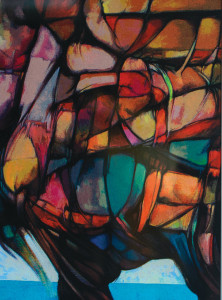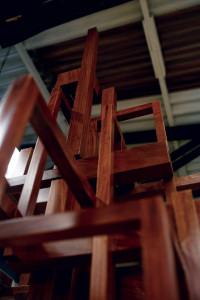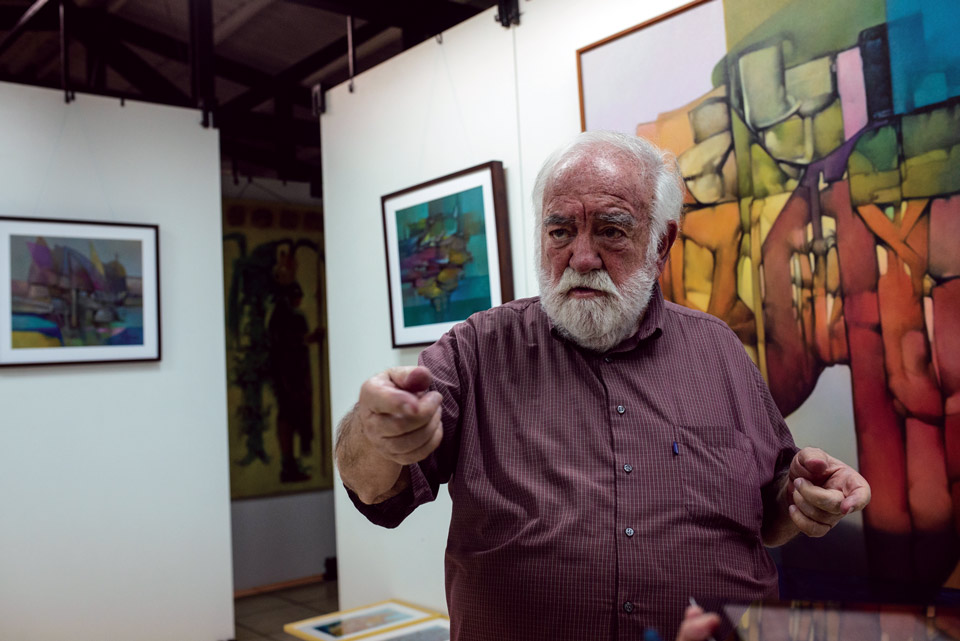Ramón Ávila: Abstractions from Within
ARTIST PROFILE by Linda Conard photos: Murphy Byrne.
When you step into an exhibit of Ramón Ávila’s paintings, you are surrounded by color, emotion and intensity. Many of his oils suggest organic elements, such as earthy roots, plant fibers and even internal organs, in forms that are progressive and reaching, complex and tangled. In other works, distinct lines and robust colors elicit a sharper, more urban impression.
Ávila refers to his work as reflexivo—arising from deep thought. “My work is very personal, very introspective,” he says. “As I paint, I allow my feelings to carry me, so my painting reflects what I am thinking, whether it is something more internal or external.”
The critical issue for Ávila, however, is not that viewers understand his thoughts as he painted, but rather that they experience the work from their own personal context. “The works are transformed in the imagination of the viewer because they can see in the paintings what they really want to feel, or what the form seems like to them,” says Ávila. “The viewer may feel something about the painting that is unlike what the artist feels.”
 Ávila’s vibrant work draws on his 80 years of life experience. He first studied art in Barcelona, Spain, where he grew up during the Spanish Civil War and World War II. In 1956, he moved to Brazil with about $40 in his pocket and found work as a publicist while he continued painting. “I almost didn’t have anything to eat when I arrived,” he says, “but it was fantastic.”
Ávila’s vibrant work draws on his 80 years of life experience. He first studied art in Barcelona, Spain, where he grew up during the Spanish Civil War and World War II. In 1956, he moved to Brazil with about $40 in his pocket and found work as a publicist while he continued painting. “I almost didn’t have anything to eat when I arrived,” he says, “but it was fantastic.”
His early work in Brazil reflected his love of abstract expression. But the early 1960s marked a significant change in his style when an opportunity to help form the Department of Creative Arts for Publicidad Centroamericana brought him to Guatemala.
“When I came to Guatemala in 1963, for me, the world changed—my life changed,” he says. “I saw another life context, another way to be human and live alongside of everyone else. …I saw a series of values that returned me to figurative work—purely figurative.”
Ávila traveled throughout Guatemala during the 1960s, painting the people, landscapes and traditions that surrounded him, using more realistic style than ever before. Nonetheless, his goal was never a strict reproduction of what he witnessed, but rather the expression of his impressions.
“When you paint a landscape, for example, you need to draw out the impression, the reflection motivated by the landscape—not copy it. You will never improve on nature. The same happens in figurative and folkloric work. You can’t improve on tradition—it’s untouchable, it’s law, it’s sacred, and it’s history,” he says.
In the 1980s, he suddenly returned to abstract painting, partly in response to a very personal loss. “It changed everything. Everything. In part, I returned to the abstract because reality didn’t exist for me. …There are many negative things that are realities. Injustice is a reality. To be inhuman is a reality. It didn’t make sense. I still find it very confusing,” he says.
 Today, Ávila continues to express his thoughts and feelings through abstract forms, often with figurative elements, in oil on canvas, pencil drawing and wood sculpture. He and his son Ricardo also painstakingly produce silkscreen prints for fine artists and commercial designers in an expansive workshop beside his painting studio in San Lucas. But above all, painting and drawing remain his passion. After more than 60 years of painting, he still feels that he’s “practicing.”
Today, Ávila continues to express his thoughts and feelings through abstract forms, often with figurative elements, in oil on canvas, pencil drawing and wood sculpture. He and his son Ricardo also painstakingly produce silkscreen prints for fine artists and commercial designers in an expansive workshop beside his painting studio in San Lucas. But above all, painting and drawing remain his passion. After more than 60 years of painting, he still feels that he’s “practicing.”
“It’s very difficult, but I paint every day. Something, a little, a lot, at times all night long, painting. I don’t have a specific time or specific way, because you don’t know when the spark—the feeling—will happen,” he says. “To me, it’s important to have a ‘trade.’ In a trade, you must practice it, you must improve it, and above all, you must exercise it. And every now and then, something good results.”
In Ávila’s case, “something good” is always extraordinary.
